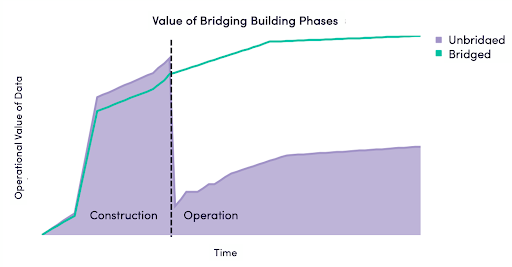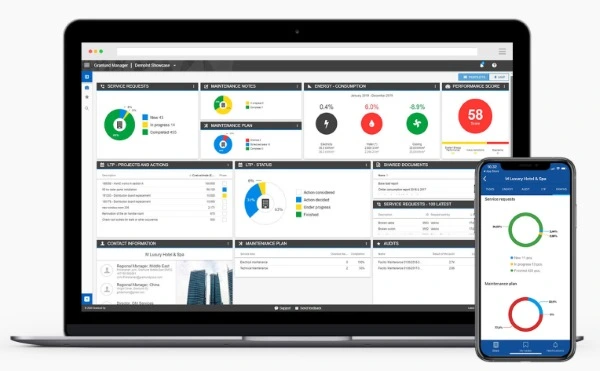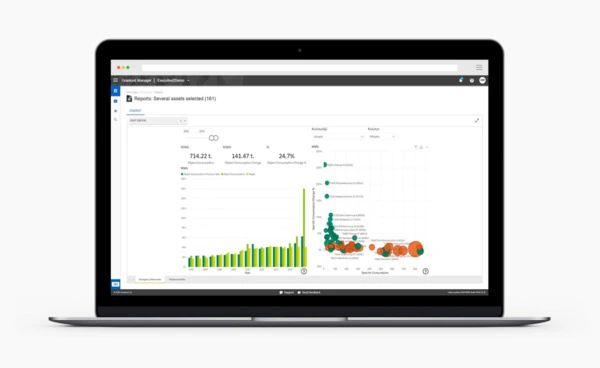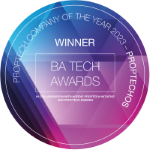Facility management is not merely about maintaining buildings and reacting to faults; it’s about proactive, data-driven decision-making. We have set out to combine digital twins and the exceptional capabilities of our partners’ applications for facility management and work order management. We already see how it brings a transformative shift in how facilities are managed and maintained. Drawing inspiration from the impressive results from Western Michigan University and others, 15% labor efficiency improvement is just the beginning. The approach gives facility managers unprecedented efficiency, cost savings, and operational excellence.
Streamlining data for enhanced facility management
A further challenge in modern facility management is the disconnect between the vast amounts of data generated during the construction phase of a building and its effective utilization during the operational phase. During construction, there is a tremendous buildup of valuable information, such as detailed specifications, equipment data, and as-built documentation. However, this data often remains underutilized due to two major issues:
- Lack of data validation: The data generated during construction is rarely validated programmatically, resulting in uncertain quality and usability information.
- Inefficient data transfer to operations: The data is often not delivered in a format or through a process that ensures smooth and effective transfer to facility management teams during the operational phase.
These challenges prevent the full potential of construction data from being realized in the building’s operational life. The solution lies in implementing a continuous programmatic informational delivery system from construction and refurbishment projects to operations, accompanied by automatic and semantic data validation to ensure its quality and usability.

Ensuring quality and usability through continuous, validated data delivery
The key to bridging the gap between construction and operations lies in a systematic approach that focuses on the continuous delivery of validated data throughout the construction process. By incorporating digital tools such as our Common Data Environment (CDE) and leveraging advanced validation technologies; we can ensure that data generated during construction is of high quality and can be effectively utilized in the operational phase. Here’s how this approach provides transformative benefits:
1. Automated data validation for reliable information
Various types of data are created during construction, including 3D models, equipment specifications, installation instructions, and more. However, this data is often inconsistent, incomplete, or inaccurate without validation, leading to inefficiencies and potential risks during operations. Our solution involves integrating automated validation checks at each stage of data generation. By ensuring that all data conforms to predefined standards and formats, we can guarantee that the information is reliable, complete, and ready for use in facility management systems. This reduces the risk of errors and improves decision-making accuracy during the building’s operational phase.
2. Continuous data delivery enables seamless transfer to operations
Traditionally, data transfer from construction to operations is a one-time, end-of-project task prone to delays and inaccuracies. By adopting a continuous data delivery approach, where information is incrementally delivered throughout the construction phase, facility managers can gradually familiarize themselves with the building’s systems and assets. This incremental approach ensures no overwhelming data dump at the end of the project and allows for smoother onboarding of operational teams. The continuous flow of validated information managed through our CDE also enables immediate corrective actions if discrepancies or gaps are identified, reducing rework and associated costs.
3. Semantic validation for enhanced usability
A key feature of our approach is semantic validation, which goes beyond simple data checks to ensure that the information is correct in form and meaningful and usable. For example, semantic validation can confirm that asset information includes a manufacturer’s name and model number and essential operational data like warranty periods, maintenance schedules, and performance parameters. This depth of validation ensures that facility managers receive actionable data, reducing the time spent on manual data correction or lookup during maintenance and operations. By ensuring that the information delivered is directly usable, we facilitate more efficient work order management, proactive maintenance, and overall better facility performance.
4. Enhanced collaboration and accountability
With a continuous, validated data delivery system, all stakeholders—including construction teams, subcontractors, and facility managers—are aligned on data standards and expectations from the outset. This alignment promotes greater collaboration, transparency, and accountability, as everyone works within a shared framework of high-quality data management. Facility managers are no longer in the dark about the assets and systems they will be managing post-handover; instead, they are equipped with reliable data to maintain the building at its highest operational efficiency from day one.
5. Realizing the full potential of digital twins
The effectiveness of digital twins in facility management is amplified when the underlying data is of high quality and continuously updated. Combining our Common Data Environment, digital twins, and programmatically validated data ensures that digital twins remain accurate reflections of the physical building. This empowers facility managers to leverage digital twins for predictive maintenance, energy optimization, and tenant management, ultimately leading to significant cost savings and enhanced building performance.
Centralizing building, asset and device data
By integrating a digital platform that consolidates all building, asset, and device data into a single, centralized repository with digital twins, we create a living, breathing digital replica of the building and its systems. This rich, centralized data source serves as a powerful foundation upon which our partner applications for facility management operate. When paired with work order management tools, our solution enables real-time, data-driven maintenance and operational decisions for facility management teams.
A 15% improvement and the benefits: Faster response times and increased efficiency
Using integrated mobile technology and digital tools, such as tablets that combine visual digital twins and deep integration with CMMS (Computerized Maintenance Management Systems), led to a 15% improvement in labor efficiency at Western Michigan University. These figures underscore the transformative impact of having instant access to complete information right at the technician’s fingertips. Our CDE solution, powered by complete digital twins and partner applications, builds upon these principles, enabling even faster response times and enhanced operational efficiency.
A data-driven future for facility management
The future of facility management lies in data-driven decision-making powered by continuous, validated information delivery. By ensuring the quality and usability of data from the construction phase and providing a seamless, incremental transfer to operations, we unlock the full potential of building information. Our Common Data Environment, coupled with digital twins and partner applications for facility and work order management, is a comprehensive solution that enables facility managers to achieve unprecedented efficiency, cost savings, and operational excellence.
Western “a library room full of books directly to our technicians’ iPads.” Our solution takes this further—ensuring that every “book” in that library is validated, actionable, and ready to transform facility management into a proactive, data-rich discipline.

Per Karlberg
Per Karlberg, a distinguished technology executive, demonstrates deep expertise in the nexus of real estate, technology, and ESG. Holding advanced degrees from Lund University, and with key roles as CEO of our company and Co-Founder of ProptechOS, he has shaped the proptech field through significant contributions to real estate technology advancements. His instrumental work in co-authoring “The realestatecore ontology” has facilitated digital transformation and ESG breakthroughs in the real estate sector.
Read his full bio and information here.











